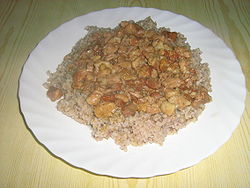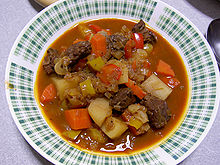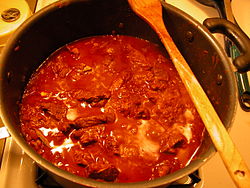- Goulash
-
For a style of play of contract bridge, see Goulash (bridge).
Goulash (plural: goulashes) is a soup or stew of meat, noodles and vegetables (especially potatoes), seasoned with paprika and other spices.[1] Originating in Hungary, goulash is also a popular meal in Austria, Croatia, Czech Republic, Romania, Scandinavia, Serbia, Slovakia, Slovenia and the north-eastern Italian region of Friuli Venezia Giulia. It is one of Hungary's national dishes[2].
 Gulyás in a traditional "bogrács" (cauldron)
Gulyás in a traditional "bogrács" (cauldron)
Contents
Etymology
The name originates from the Hungarian gulyás [ˈɡujaːʃ] (
 listen). The gulya word means 'herd' in Hungarian, gulyás 'neat-herd'.[3][4]
listen). The gulya word means 'herd' in Hungarian, gulyás 'neat-herd'.[3][4]In Hungary
Gulyás
Main article: GulyáslevesIn Hungarian cuisine, traditional gulyásleves (lit. "goulash soup"), bográcsgulyás,[5] pörkölt, and paprikás are thick stews made by cattle herders and stockmen. Garlic, tomato, caraway seed, bell pepper, and wine are optional. One may alternatively prepare these dishes as soups rather than stews. Excepting paprikás, the Hungarian stews do not rely on a flour or roux for thickening.
Goulash can be prepared from beef, veal,[6] pork, or lamb. Typical cuts include the shank, shin, or shoulder; as a result, goulash derives its thickness from tough, well-exercised muscles rich in collagen, which is converted to gelatin during the cooking process. Meat is cut into chunks, seasoned with salt, and then browned with sliced onions in a pot with oil or lard. Paprika is added, along with water or stock, and the goulash is left to simmer. After cooking a while, garlic, whole or ground caraway seeds, or soup vegetables like carrot, parsnip, peppers (green or bell pepper), celery and a small tomato may be added. Other herbs and spices could also be added, especially hot chili peppers, bay leaf and thyme.[5] Diced potatoes may be added, since they provide starch as they cook, which makes the goulash thicker and smoother. A small amount of white wine or wine vinegar may also be added near the end of cooking to round the taste. Goulash may be served with small egg noodles called csipetke.[7] The name Csipetke comes from pinching small, fingernail-sized bits out of the dough (csip =pinch) before adding them to the boiling soup.
Hungarian goulash varieties
Hungarian goulash variations[8]
- Gulyás à la Székely. Reduce the potatoes and add sauerkraut and sour cream.
- Gulyás Hungarian Plain Style. Omit the home made soup pasta (csipetke) and add vegetables.
- Mock Gulyás. Substitute beef bones for the meat and add vegetables. Also called Hamisgulyás, (Fake Goulash)
- Bean Gulyás. Omit the potatoes and the caraway seeds. Use kidney beans instead.
- Csángó Gulyás. Add sauerkraut and rice instead of pasta and potatoes.
- Betyár Gulyás. Use smoked beef or smoked pork for meat.
- Likócsi Pork Gulyás. Use pork and thin vermicelli in the goulash instead of potato and soup pasta. Flavour with lemon juice.
- Mutton Gulyás or Birkagulyás. Made with mutton. Add red wine for flavour.
A thicker and richer goulash, similar to a stew, originally made with three kinds of meat, is called Székely gulyás, named after the Hungarian writer, journalist and archivist József Székely (1825–1895).[5]
Some cookbooks suggest using roux with flour to thicken the goulash, which produces a starchy texture and a blander taste. Others suggest using a vast amount of tomatoes for colour and taste. A small amount of tomatoes in the stock that is used, or a drop of tomato purée, may improve the taste and texture, but the original goulash is a paprika-based dish and the taste of tomatoes should not be discernible. Many Hungarian chefs consider tomatoes to be absolutely forbidden in goulash and they also feel that if they cook a stew instead of a soup, it should only be thickened by finely chopped potatoes, which must be simmered along with the meat.
Paprikás krumpli
"Paprikás krumpli" is a paprika-based potato stew in which diced potatoes replace the meat, with onion, tomato, bell peppers, ground paprika and some bacon or sliced spicy sausage, like the Debrecener sausage. In German-speaking countries, Kartoffelgulasch ("potato goulash") is a less-expensive goulash-substitute, made with sausage; similar to "Paprikás krumpli". Paprikás krumpli is a proverbial, traditional, tasty poor man's dish in Hungary.
Outside Hungary
Thick stews similar to pörkölt and the original cattlemen stew are popular throughout almost all the former Austrian-Hungarian Empire, from Northeast Italy to the Carpathians. Like pörkölt, these stews are generally served with boiled or mashed potatoes, polenta, dumplings, spatzle or, alternatively, as a stand-alone dish with bread.
Goulash in Austria
In Vienna, the former center of the empire, a special branch of the Goulash had been developed. The "Wiener Saftgulasch" or the "Fiakergulasch" on the menu in traditional restaurants is a must have. It is a rich Pörkölt like stew, more onions but no tomatoes or other vegetables are used and it comes usually just with dark bread. A variation of the "Wiener Saft Gulasch" is the "Fiaker Gulasch" which is served with fried egg, fried sausage and dumplings named "Semmelknödel".
Goulash in Germany
Gulasch, Rindergulasch or Gulaschsuppe is a beef[9] stew with potatoes in cream of mushroom soup.
Goulash in Italy
Goulash is found, in Italy, in the region of Friuli-Venezia Giulia and the autonomous Trentino-Alto Adige/Südtirol region, as a regular Sunday dish;[citation needed] it can be sometime found also in the nearby Veneto, where it is less typical.
Australian and North American goulash
In Australia, Canada and the United States, various adaptations have made the dish more suitable for local preferences. Minced beef frequently replaces cut beef in the recipe[citation needed], which reduces the cost as well as the cooking time. The meat and onions are then placed in the pan, the other ingredients are added and the dish might be ready to serve in as little time as 20 to 30 minutes. This goulash is commonly finished by the addition of noodles, pasta, or elbow macaroni. This form of the dish was made popular by its inclusion in popular cookbooks in the early and mid twentieth century, such as Betty Crocker's Cookbook and the Margaret Fulton Cookbook.
- Goulash is also a slang term in some parts of the United States, particularly the South, for a dish made with miscellaneous left-overs. Noodles or potatoes are usually added thereafter.
- In parts of New England and the Midwest, Goulash can refer to a pasta dish with ground beef and tomato sauce also known as American Chop Suey.
Goulash in the Slavic Cuisines
 Polish gulasz with kasha
Polish gulasz with kasha
Goulash (Croatian: Gulaš) is also very popular in most parts of Croatia, especially north (Hrvatsko Zagorje) and Lika. It's considered to be part of traditional cuisine. In Gorski Kotar and Lika deer and boar frequently replace beef - Lovački gulaš. There is also Goulash with porcini mushrooms (Gulaš od vrganja). Bacon is an important part of Croatian goulash.
Gulaš is often served with fuži, njoki, palenta or pasta. In Croatian, Bosnian and Serbian ciganski gulaš) is augmented with vegetables. Green and red bell peppers and carrots are most commonly used. Sometimes one or more other kinds of meat are added, e.g. pork loin, bacon, or mutton. In Slovenia, they are known as Perkelt, but are often referred to as "goulash" or a similar name.
In Slovene partizanski golaž, partisan goulash, favoured by Slovenian partisans during the Second World War, and still regularly served at mass public events; most meat is replaced with quartered potatoes. It's not as thick as goulash, but thicker than goulash soup.
Goulash (Polish: Gulasz) is also popular in Poland, dish is similar to Hungarian Pörkölt and it is usually eaten with buckwheat kasha.
In Serbia, Goulash (Serbian: Гулаш) is eaten in most parts of the country, especially in Vojvodina where it was probably introduced by the Hungarian minority. It is actually a Pörkölt, usually made with beef or veal, but also with some other types of meat like pork or lamb. Goulash made with venison is also popular. in Serbia, goulash is most often served with boiled potatoes or potato mash.
In Czech Republic, goulash is usually made with beef and served with bread dumplings (hovězí guláš s knedlíkem) or with bread. In some regions it is garnished with slices of fresh onion. It is typically accompanied by beer. Beer can be also added to the stew in the process of cooking. In Czech slang, the word guláš means "mishmash", typically used as mít v tom guláš: to be disoriented or to lack understanding of something.
Other
- "Goulash Communism" is used to describe the maverick brand of Communism practiced by Hungary during the Cold War, characterized by some degree of political freedom within the Hungarian Communist Party as well as limited economic freedom and freedom of speech, inspired at least in part by the 1956 Hungarian Revolution.
- Writer and filmmaker Stephanie Yuhas published a series of short stories and films in 2007 called American goulash, a term used to describe the medley of culture a person develops as a Hungarian American.
See also
References
Gundel's Hungarian Cookbook, Karoly Gundel, Budapest, CORVINA. ISBN 963 13 3733 2 Betty Crocker's Cookbook
Notes
- ^ Gundel, Karoly (1992). Gundel's Hungarian cookbook. Budapest: Corvina. ISBN 963-13-3600-X. OCLC 32227400.page 20
- ^ Food Journeys of a Lifetime: Top Ten Great National Dishes | Away.com
- ^ William White, Notes and queries, Volume 126, Oxford University Press, 1912
- ^ Judith Petres Balogh, This Old House by the Lake, Trafford Publishing, 2006, p. 244
- ^ a b c Gundel's Hungarian Cookbook, Karoly Gundel.
- ^ Famous Hungarian recipes
- ^ Gundel, Karoly (1992). Gundel's Hungarian cookbook. Budapest: Corvina. ISBN 963-13-3600-X. OCLC 32227400.page 31
- ^ Gundel, Karoly (1992). Gundel's Hungarian cookbook. Budapest: Corvina. ISBN 963-13-3600-X. OCLC 32227400.page 21
- ^ Rindergulasch Lieblings-Rezepte
External links
- Goulash at the Open Directory Project
Categories:- Soups
- Stews
- Beef dishes
- National dishes
- Hungarian cuisine
- Hungarian loanwords
- American cuisine
- Albanian cuisine
- Austrian cuisine
- Bosnia and Herzegovina cuisine
- Croatian cuisine
- Slovak cuisine
- Czech cuisine
- Montenegrin cuisine
- Republic of Macedonia cuisine
- Polish soups
- Serbian cuisine
- Lithuanian cuisine
- Russian soups
- Ukrainian soups
Wikimedia Foundation. 2010.




